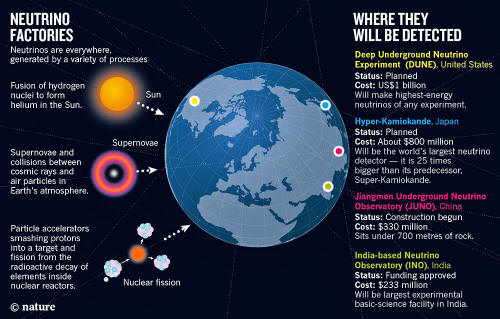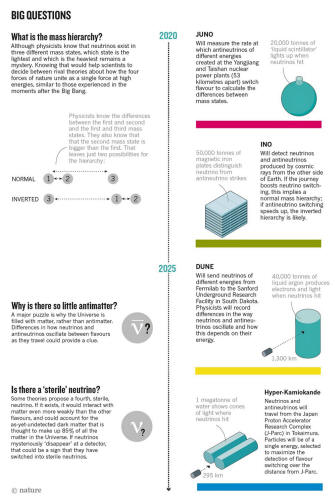|

by Elizabeth Gibney
12 August 2015
from
Nature Website
A graphical guide
to four giant experiments
spread across the world.
As
researchers at CERN, Europe's particle-physics laboratory near
Geneva, dream of super-high-energy colliders to explore the Higgs Boson, their counterparts in other parts of the world are pivoting
towards a different subatomic entity:
the neutrino.
Neutrinos are more abundant than any particle other than photons,
yet they interact so weakly with other matter that every second,
more than 100 billion stream - mainly unnoticed - through every
square centimeter of Earth.
Once thought to be massless, they in
fact have a minuscule mass and can change type as they travel, a
bizarre and entirely unexpected feature that physicists do not fully
understand.
Indeed, surprisingly
little is known about the neutrino.
"These are the most ubiquitous
matter particles in the Universe that we know of, and probably
the most mysterious," says Nigel Lockyer, director of the Fermi
National Accelerator Laboratory (Fermilab) in Batavia, Illinois.

Graphic by Nigel Hawtin
Four unprecedented experiments look poised to change this.
Two - one
in China and one in India - already have the go-ahead, and plans to
erect detectors in Japan and the United States are in the works.
Buried underground to prevent
interference from other particles, all four are designed to detect
many more neutrinos, and to probe the switching process in more
detail, than any existing experiment.

Graphic by Nigel Hawtin
The results are expected to feed into some of the most fundamental
questions in cosmology.
Some of the experiments will make their
own neutrinos; all will use any they can capture from the Sun or
from supernova explosions.
"The age of the neutrino," Lockyer
says, "could go on for a very long time."
Flurry of
experiments
The detectors in China (JUNO) and India (INO) are designed to
untangle the relationship between the three mass states, with
implications for the origins of the forces of nature.
By contrast,
DUNE in the United States
and
Hyper-Kamiokande in Japan aim to spot differences in how
neutrinos and antineutrinos oscillate between flavors. That could
solve a second cosmological puzzle:
why the Universe is made up of
matter rather than antimatter.
All four detectors will also hunt for a
hypothesized 'sterile' neutrino.

|




